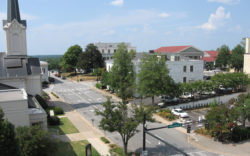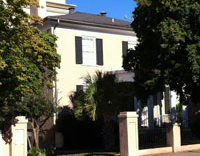Back in 2008 I noted a few privately owned sites that we should be watching closely in the downtown area: Armstrong & Dobbs, Potterytown along the North Oconee River, Athens Hardware and Saint Joseph’s. Three of the four have since been the subject of major development initiatives, with the Selig Walmart proposal at A&D, the River District, and now a six-story residential development on the Athens Hardware site. This latest project would include over 600 bedrooms, and as many parking spaces, in two structures. As I also noted in 2009, in the throes of the financial downturn, “The economic lull is almost over and growth is coming; if we don’t consider carefully now what that means, we’ll be screwed.â€
Too late. Our supposedly progressive Commission has squandered a perfectly good recession, and as the real estate market has started to regain its pulse, developers have been rushing to entitle property all over the city. Even if a significant planning effort were undertaken now, developers of many of the significant properties in these areas would already have building permits in hand that allow for the kinds of bad development those efforts aim to prevent.
Aside from the well-documented Walmart proposal and the terribly planned under-construction Classic Center, there are two five-story student housing projects waiting in the wings on either end of Broad Street. Another is proposed to be built on the site of Easley Mill, blasting away the historic and ecologically significant granite outcrop there. There’s a stalled proposal for a five-story building on a parking lot on Broad between College and Lumpkin. And let’s not forget the hotel we were promised in exchange for Hancock Avenue’s closure for the civic center expansion, which has not yet been formally submitted, but is still out there.
Further out, we have four new proposed medical buildings. A pair would rise just east of Milledge on Prince, while another would tower four stories above Normaltown on the former site of Allen’s, with a massive three-story parking deck facing houses on Yonah Avenue. A five-story medical building would be situated on West Broad, just past King Avenue. And then there are residential complexes under construction, several of them student housing, including two looming over Barnett Shoals Road, and another that backs up to the Greenway. That’s not to mention the infill housing that’s been ramping up in various neighborhoods, especially those surrounding Athens Regional Medical Center.
It’s not that all of these projects, ill-conceived as some of them are, will come to fruition. It’s that they very well could, and there’s nothing any of the citizens who would encounter them daily can do about it, because of the lack of foresight on the part of their representatives. There might not be much left of this quirky college town if even some of this development comes to pass… At least we have Caterpillar.
Let’s not forget the T-SPLOST, which we’ll be voting on in a few short months. That sketchy list of projects was generated from existing plans for transportation improvements. Thus, if we’d planned better for the future, we might have had a larger list of projects GDOT and the regional taskforce could have culled to produce the projects on the referendum. As it stands, the vast majority of funds, if voters approve the one-cent sales tax, will go to a new interchange and supporting roads for the Loop at Mitchell Bridge, as well as widening all of the rural roads that feed into the city. Lexington Highway, Tallassee Road and portions of Winterville Road would all be widened into four-lane highways. All of those routes, of course, feed into two- and three-lane streets inside the Loop (Oconee, Oglethorpe and Peter, respectively), but there’s no money proposed to deal with the bottlenecks these sorts of projects would create.
Of course, the two-years-in-the-making corridor studies do look at some of these areas, but the process has been too slow, and has produced only a menu of potential solutions rather than any comprehensive strategy. And the results are non-binding: should the Commission identify any of the studies’ initiatives as suitable, it’ll likely take another months-long process to enact them.
This brought out quite a bit of frustration in a public input meeting over the Oak-Oconee study; there, citizens concerned about a looming project learned that even though this study made suggestions that might affect the ongoing Selig controversy, like a cap on retail square footage in a portion of the corridor, the studies’ recommendations were too little, too late.
We could move more quickly if we wanted to, though; consider that in a month, we went from the Caterpillar announcement to developing a new zoning overlay for the Orkin tract, designing new roads and breaking ground. If properly motivated, government can apparently move efficiently and effectively. So, why hasn’t a decade or more of concern compelled commissioners to budge on Prince, downtown, or elsewhere?
People who claim to care about Athens have paid lip service to that notion too long. Our elected leadership has failed, certainly, but the blame is just as much on the community that they represent. The resources are here, in terms of both talent and finances. The well-planned, well-implemented cities that we cite as models made the investment in their futures—partnerships between business, the philanthropic community and government—and that’s why they succeeded. The future economic health of this community isn’t built on student housing and a Walmart, and the business community needs to recognize that consensus-driven regulation of development is ultimately better than that for prosperity in the long term. Likewise, the philanthropic elements of the community that have been making small efforts around the edges of this city’s problems must find a way to make a more substantive and dramatic effort to turn things around. And the politicians, too, must be willing to take a risk, rather than holding back out of fear that whoever might replace them if they go too far would be worse. We don’t have a day to wait.
Like what you just read? Support Flagpole by making a donation today. Every dollar you give helps fund our ongoing mission to provide Athens with quality, independent journalism.










